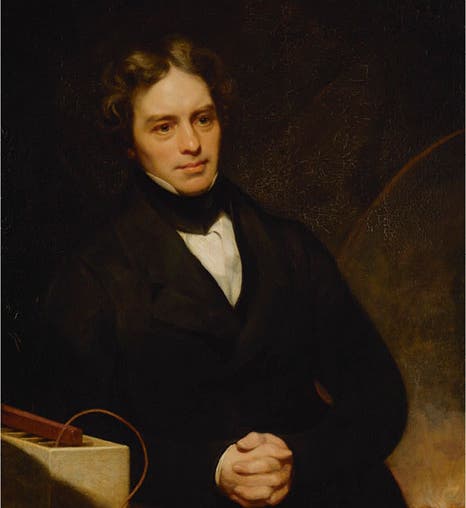Scientist of the Day - Michael Faraday
Michael Faraday, an English chemist and physical scientist, was born Sep. 22, 1791. Faraday's entry into the academic world was one of the great rags-to-(academic) riches stories in science. Faraday came from a lower-class family, had no formal education, and was entirely self-taught. He spent 7 years as a book-binders apprentice, which is when he discovered an interest in science. In 1812, when 20 years old, he was given tickets to a series of lectures by Humphry Davy, the renowned chemist, at the Royal Institution of London. At the end of the series, Faraday wrote up his notes, illustrated with his own drawings of apparatus, and sent them to Davy. Davy was so impressed that he hired Faraday as a kind of secretary, and then, when a vacancy opened up in 1813, he made Faraday his assistant. It took Faraday some time to penetrate the class-bound scientific culture of the day, but he prevailed, and he went on to become not only a brilliantly original scientist, especially in his studies of electricity and magnetism, but also probably the best experimental demonstrator of his day, eclipsing the considerable reputation of Davy.
On Aug. 29, 1831, Faraday did perhaps his most famous experiment, in his laboratory at the Royal Institution. He wrapped a wire around an iron doughnut and connected it to a battery, via a switch. He wrapped a separate wire around the other side of the doughnut and connected it to a simple galvanometer, which can detect an electric current. Faraday found that when he closed the switch, the meter, for just a moment, indicated the presence of a current, before returning to zero. When he opened the switch, the meter flickered again, then returned to zero once more. Faraday had discovered electromagnetic induction – that a changing electric current produces a magnetic field that will induce a current in another wire that lies near it, especially if both are wrapped around a piece of iron. The key is that the current and its magnetic field have to be changing, or the wire or magnet has to be moving, to induce the current. What induction makes possible, as Faraday soon discovered, was the first electric generator, where a rotating magnet induces a continuous electric current, and the first electric motor, where a continuous current running through a loop of wire makes it rotate. Faraday went on to publish 29 papers on electromagnetism in the Philosophical Transactions between 1831 and 1838, and much of his work was incorporated by James Clerk Maxwell in his definitive work on electromagnetism in the 1860s.
One of Faraday's greatest legacies is the series of lectures known as the Christmas Lectures. These were initiated by Faraday in 1825 at the Royal Institution and offered over the Christmas holiday, the intention being to give the general public the opportunity to learn about scientific topics, from lectures intended specifically them. They proved to be enormously successful and are still offered. Faraday himself delivered 19 Christmas lectures (although not the first), including all ten offered in the decade of 1851-60. There is a drawing that shows Faraday delivering a Christmas lecture in 1855 or 1856, with none other than Prince Albert in attendance (second image).
In the Royal Institution today, you will find the Faraday Museum; they have preserved his original laboratory, and have many Faraday-related artifacts, such as his wire-wound electromagnetic donut. It is interesting to compare the actual lab with an engraving made in 1870 that also depicts Faraday’s lab (with Faraday in it ; third image). The RI also commissioned a marble statue back in the 1870s, by John Henry Foley; it still stands at the foot of the main staircase. You are more likely to run across a bronze copy that was made long ago and placed in front of the Institution for Engineering Technology, along the Victoria Embankment.
Faraday also has a plaque in Westminster Abbey (although he is not buried there), as well as an SI unit, the Farad (a unit of capacitance), named after him, but his greatest honor might have been replacing William Shakespeare on the £20 note in 1991 (the back of the note shows Faraday giving a Christmas Lecture). Unfortunately, in 1999, Faraday himself was replaced on the £20 note by composer Edward Elgar. It seems the Faraday £20 note was being rampantly counterfeited. Elgar didn't fare much better, as his note was also much abused, and so Elgar was replaced by Adam Smith in 2007. Who would dare counterfeit a note with an economist on it!
The portrait of Faraday (first image) was painted by Thomas Phillips in 1841-42, and is in the National Portrait Gallery in London.
Dr. William B. Ashworth, Jr., Consultant for the History of Science, Linda Hall Library and Associate Professor emeritus, Department of History, University of Missouri-Kansas City. Comments or corrections are welcome; please direct to ashworthw@umkc.edu.








